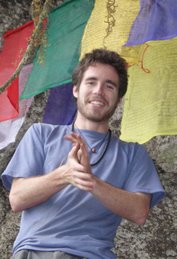 The entire group of dentists (11 Singaporean, 2 Nepali) and volunteers at the Shenpen Dental Clinic 2007.
The entire group of dentists (11 Singaporean, 2 Nepali) and volunteers at the Shenpen Dental Clinic 2007.I also escorted the dentists to the Shivapuri National Forest north of Kathmandu on a holiday between our clinics in Boudha and Chapgaon. It was nice to get into nature in a vast forest filled with the blessings of previous Buddhas and years of meditating yogis.
 The view from a meditation cave in the Shivapuri forest. Oh, the virtue of the happy life of the hermit!
The view from a meditation cave in the Shivapuri forest. Oh, the virtue of the happy life of the hermit! Rhododendrons in full bloom in Shivapuri forest.
Rhododendrons in full bloom in Shivapuri forest. A tree-dwelling near the peak of Shivapuri, used by those looking for solitude in the forest.
A tree-dwelling near the peak of Shivapuri, used by those looking for solitude in the forest.SHOTS OF THE 2007 SHENPEN DENTAL CLINIC, CHAPAGAON:
 A Nepali (Newari) villager in traditional dress getting his teeth cleaned.
A Nepali (Newari) villager in traditional dress getting his teeth cleaned. A Nepali woman having minor dental surgery done behind our monastery in the village.
A Nepali woman having minor dental surgery done behind our monastery in the village. Another Nepali villager having her teeth worked on.
Another Nepali villager having her teeth worked on. Dan Bahadur, the gate keeper at our Chapagaon monastery, smiling after getting a teeth cleaning.
Dan Bahadur, the gate keeper at our Chapagaon monastery, smiling after getting a teeth cleaning. Dan Bahadur's beautiful wife.
Dan Bahadur's beautiful wife. A beautiful village girl who came from her home nearby the monastery in Chapagaon for a teeth cleaning.
A beautiful village girl who came from her home nearby the monastery in Chapagaon for a teeth cleaning. The beautiful village girl with her beautiful friend.
The beautiful village girl with her beautiful friend. A local schoolgirl crying as she gets two of her heavily decayed lower molars extracted. Dentistry is pain!
A local schoolgirl crying as she gets two of her heavily decayed lower molars extracted. Dentistry is pain! Our smallest monk at the Chapagaon monastery getting his teeth checked by one of the Singaporean dentists, Cheung.
Our smallest monk at the Chapagaon monastery getting his teeth checked by one of the Singaporean dentists, Cheung. Elderly village men, in traditional attire, waiting for a checkup.
Elderly village men, in traditional attire, waiting for a checkup.HIMACHAL PRADESH, INDIA, MARCH 2007:
A few images from my trip to India in the first two weeks of March, where I attended teachings by His Holiness the Dalai Lama, and visited the reincarnation of Tulku Orgyen Rinpoche in Bir.
 An abandoned bike rickshaw at the bus station in Paharganj, Punjab, India.
An abandoned bike rickshaw at the bus station in Paharganj, Punjab, India. OM AH HUNG VAJRAGURU PADME SIDDHI HUNG! A mantra written on a stone at the Chokling Monastery in Bir, Himachal Pradesh, India. Homage to Guru Rinpoche!
OM AH HUNG VAJRAGURU PADME SIDDHI HUNG! A mantra written on a stone at the Chokling Monastery in Bir, Himachal Pradesh, India. Homage to Guru Rinpoche! His Eminence the Neten Chokling Rinpoche conducting the Tsegar Drupchen, associated with Amitayus, the Buddha of Long Life, in his monastery in Bir, Himachal Pradesh, India. He is the lama that made the milarepa movie.
His Eminence the Neten Chokling Rinpoche conducting the Tsegar Drupchen, associated with Amitayus, the Buddha of Long Life, in his monastery in Bir, Himachal Pradesh, India. He is the lama that made the milarepa movie.SHOTS OF CHAPAGAON MONKS:
 My monk friend Tsultrim, who at the age of 17 pretty much runs the daily operations of the monastery in Chapagaon where I live.
My monk friend Tsultrim, who at the age of 17 pretty much runs the daily operations of the monastery in Chapagaon where I live. Some Chapagaon monks smiling.
Some Chapagaon monks smiling. Some of the younger monks in Chapagaon in assembly for afternoon prayers.
Some of the younger monks in Chapagaon in assembly for afternoon prayers.




